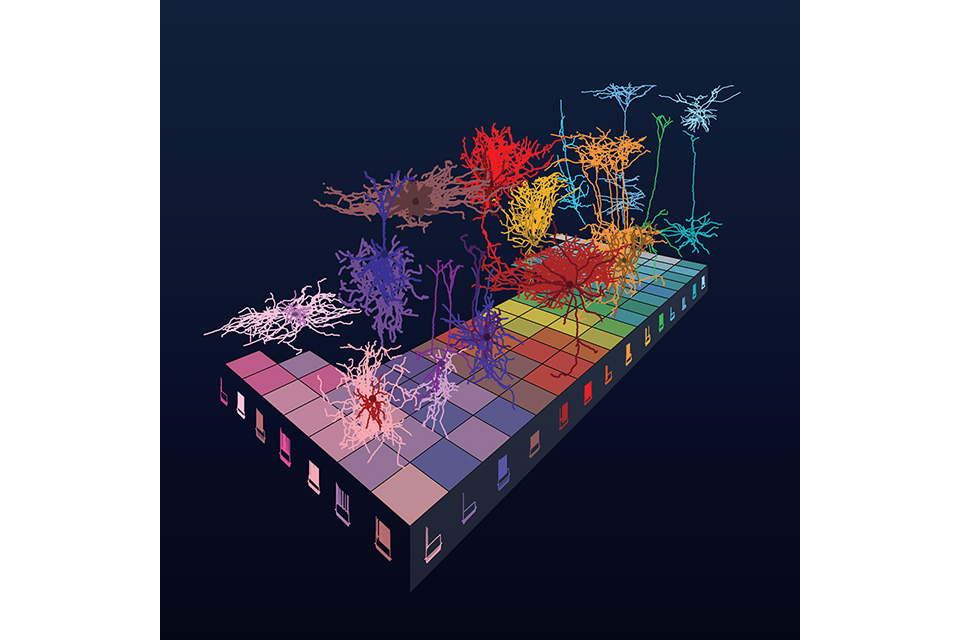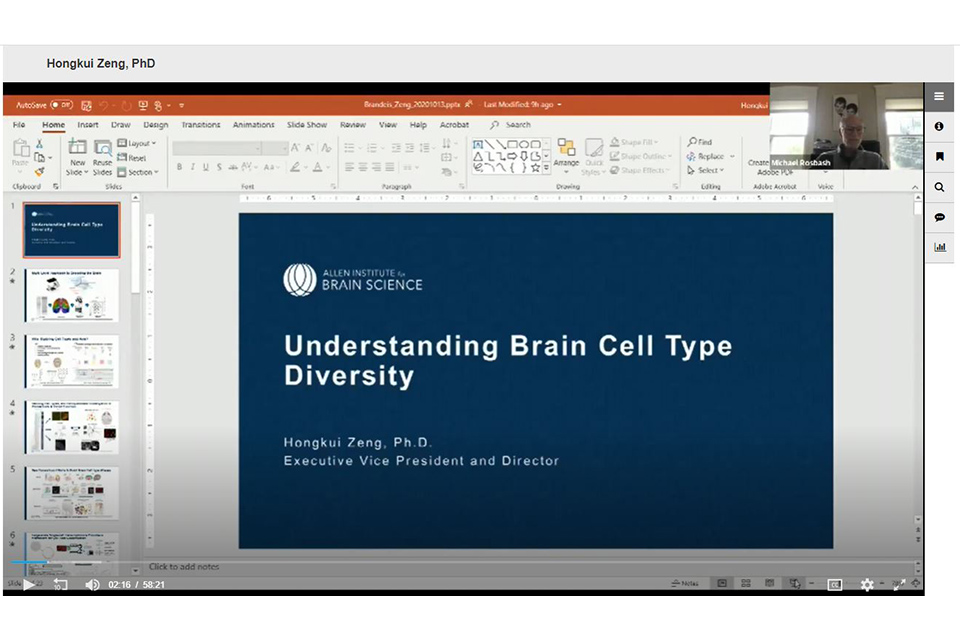Hongkui Zeng, PhD
Executive Vice President and Director
Allen Institute for Brain Science
(October 13, 2020)
Understanding Brain Cell Type Diversity
To understand the function of the brain and how its dysfunction leads to brain diseases, it is essential to have a deep understanding of the types of cells of the brain, how the cell types are connected with each other and what their roles are in how circuits of cells function. Dr. Zeng discussed the team science approach the Allen Institute has taken to systematically characterize the molecular, physiological, structural, and connectional properties of brain cell types, towards a multi-modal cell atlas for the mouse and human brains. These studies reveal extraordinary cellular diversity and underlying rules of brain organization, and provide foundational resources for the field to unravel mechanisms of brain function.
 To enable data-driven classification of brain cell types, Dr. Zeng’s team built multiple platforms and pipelines, including single-cell transcriptomics, spatial transcriptomics, single and multi-patching electrophysiology, and brain-wide neuronal morphology reconstruction, to collect gene expression, morpho-electric and connectional datasets at single cell level in a standardized manner. Computational analyses of these large-scale datasets resulted in a multi-modal integrated taxonomy of cell types in the mouse cortex. These projects also contribute significantly to the BRAIN Initiative Cell Census Network’s efforts with the goal of creating a cell atlas for the entire mouse brain.
To enable data-driven classification of brain cell types, Dr. Zeng’s team built multiple platforms and pipelines, including single-cell transcriptomics, spatial transcriptomics, single and multi-patching electrophysiology, and brain-wide neuronal morphology reconstruction, to collect gene expression, morpho-electric and connectional datasets at single cell level in a standardized manner. Computational analyses of these large-scale datasets resulted in a multi-modal integrated taxonomy of cell types in the mouse cortex. These projects also contribute significantly to the BRAIN Initiative Cell Census Network’s efforts with the goal of creating a cell atlas for the entire mouse brain.
Using the highly scalable single-cell RNA-sequencing approach, Dr. Zeng’s team has profiled ~1.2 million cells across the mouse isocortex and hippocampal formation, two major brain structures playing critical roles in perception, cognition, emotion and learning and each containing multiple subregions. They identify 379 transcriptomic cell types from this dataset and find that cell types are organized in a hierarchical manner and exhibit varying degrees of discrete or continuous relatedness with each other. Such molecular relationships correlate strongly with the cell types’ spatial distribution patterns which can be region-specific, or shared across multiple regions, or forming gradients in one or more dimensions. Glutamatergic neuron types display much greater diversity than GABAergic neuron types, both molecularly and spatially. Glutamatergic cell types from the hippocampal formation (i.e. the more ancient archicortex) are highly distinct from those from the isocortex (aka neocortex), yet the two sets of cell types also possess shared molecular signatures and corresponding layer specificities, suggesting that features of cellular diversity can reveal evolutionary relationships between regions and cell types.
To better understand the relationship between cell types’ transcriptomic profiles and other structural and functional properties, Dr. Zeng’s team used the Patch-seq technique to characterize the transcriptomes and intrinsic physiological properties of over 4,200 mouse visual cortical GABAergic interneurons and reconstructed the local morphologies of 517 of those neurons. They find that most transcriptomic types (t-types) occupy specific laminar positions within visual cortex and exhibit consistent electrophysiological and morphological properties. These properties display both discrete and continuous variation among t-types. Through multimodal integrated analysis they define 28 met-types (reduced from 61 t-types) to maximize congruency and robust mutual predictability among morphological, physiological, and transcriptomic properties. These met-types represent a unified definition of cortical GABAergic interneuron types that can bridge analyses across different modalities.
In an effort to link morphological and connectional properties of long-range projection neurons with their transcriptomic identities, Dr. Zeng’s team generated, reconstructed and analyzed the brain-wide complete morphologies of ~1,700 neurons from the striatum, thalamus, cortex and claustrum, labelled by cell-type-selective Cre lines. They find that different neuron types from different regions follow distinct rules in convergent or divergent projection, feedforward or feedback axon termination patterns, and within-type homogeneity or heterogeneity. Major molecularly defined types of neurons have correspondingly distinct projection patterns, however, the data also reveal remarkably extensive morphological and projection diversity at individual cell level within the major types that do not correlate with predefined transcriptomic subtypes. These results reveal further complexity of brain cell type diversity and suggest many ways different cell types and individual neurons may contribute to the function of their respective circuits through their unique projection patterns.

Visual abstract from Hongkui Zeng's talk
